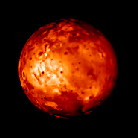 B
B C
C
A B
B C
C
The first picture (A) is an infrared image of Io taken at 18:00 UT on 2nd March 1995 with the NASA Infrared Telescope Facility (IRTF) on Mauna Kea, Hawaii. The picture, taken at a wavelength of 3.5 microns, was obtained using the facility infrared camera, "NSFCAM." It shows a major volcanic eruption (the white spot) on Io's fainter disk, which shows in orange: the size (only 0.94 arcseconds diameter) and approximate location of the disk is shown by the dotted circle. The spot off the edge of Io in the 8 o'clock position is an artifact of the telescope optics and the atmospheric conditions, exaggerated by the square-root stretch used in processing the image. High winds and the fact that the images were taken after sunrise made viewing conditions less than ideal, but the resolution is still, remarkably, better than 0.5 arcseconds.
The second frame (B) shows a Voyager image (visible light) of the side of Io seen in the March 2nd infrared image, with the same size and orientation, so that the approximate location of the hot spot can be seen. Estimated location is 40 S, 95 W, with a current uncertainty of +/- 15 degrees: more sophisticated analysis should improve the position determination. No hot spot had been seen at this location before, and this is the brightest hot spot ever seen on Io for which an accurate location can be determined directly from the data.
The third picture (C), another infrared image, was taken at 3.8 microns at 17:30 UT on March 9th, seven days after the discovery. The volcano is still evident, but the infrared radiation emitted has now faded to a small fraction of what it was on 2nd March. This is also a daytime image, taken using NSFCAM's real-time shift-and-add mode.
Both images use NSFCAM's 0.06 arcsecond per pixel plate scale, which is ideal for high-resolution imaging of small objects like Io.
The infrared images were taken during an observing run at the IRTF dedicated to the "Jason Project," a series of live telecasts to school students around the world showing scientists studying volcanoes on the Big Island of Hawaii. The IRTF participated in this educational project, focusing on observations of volcanic activity on Io. The IRTF astronomers were able to report the discovery and broadcast images of the Io eruption within an hour of first discovering it at the IRTF.
The discovery was made by John Spencer (Lowell Observatory), Jane Spencer, and David Griep (IRTF).